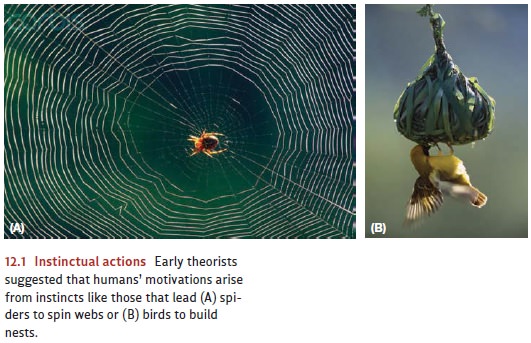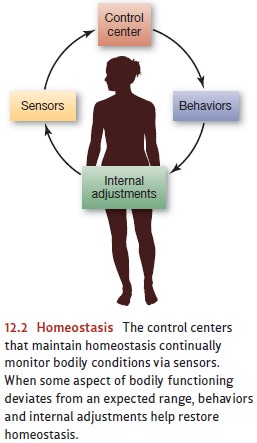Chapter: Psychology: Motivation and Emotion
Motivational States
MOTIVATIONAL STATES
Questions
about why we act in a certain way, or why we feel as we do, can be answered in
various ways. Some answers emphasize what we referred as ultimate causes,
including the powerful influence, over thousands and thousands of years, of
natural selection. This reflects the key fact that, as we saw in that earlier,
evo-lutionary forces have shaped not only our physical features but also our
psychological features.
Other
answers about why we act or feel as we do focus on causes that are specific to
the individual, but are nonetheless fairly remote from the present situation.
For exam-ple, why do some people prefer to take psychology courses, while
others prefer astro-physics? Here, the cause may be rooted in the person’s
childhood. Perhaps the person happened to experience unusual events, and this
triggered a lifelong interest in human behavior and mental processes. Or
perhaps the person is seeking to distance herself from her parents, and her
parents have always been skeptical about psychology. In either case, these
decades-past circumstances are now shaping the person’s behavior.
Important
as these remote causes are, they do not tell us everything we need to know.
After all, we do not eat because we think, “Natural selection requires that I
eat.” Likewise, we usually do not choose courses by reasoning through “Will
this selection help me to be different from my mother?” We need to ask,
therefore, what the bridge is between remote causes, on the one side, and
actual behaviors, on the other. What are the more immediate causes of our
behavior?
The
answer to this question can take many forms, because, quite simply, we are
moti-vated by different forces in different circumstances. Early theorists
emphasized the bio-logical roots of our motivation, describing our diverse
motivational states as all arising from genetically endowed instincts. Early theorists such as
William James (1890) thought humans were impelled by innate motives that were
activated by features of the environment, much as spiders spin webs and birds
build nests (Figure 12.1). Following James’s lead, early psychologists drew up
lists of instincts that they believed governed human behavior. Thus, for
example, William McDougal (1923) asserted that humans have 13 instincts,
including parenting, food seeking, repulsion, curiosity, and gregari-ousness
(i.e., a tendency to seek out social contact).

Unfortunately,
different theorists came up with quite different lists of instincts, and in
1924, sociologist Luther Bernard counted over 5,000 instincts that had been
proposed by one scholar or another. This meant that instinct theory was—at
best— inelegant, but, worse, commentators increasingly wondered what work the
theory was actually doing. What did it mean to “explain” the impulse to parent
one’s children by postulating a “parenting instinct”? We could, on this model,
“explain” why people vote by asserting that there is a “self-governance
instinct,” and explain why they go shop-ping by asserting a “shopping
instinct.” In each case, our “explanation” merely provides a new bit of jargon
that offers us no new information.
A different conception of motivation turns out to be more productive. More than a century ago, the French physiologist Claude Bernard (1813–1878) noted that every organism has both an external environment and an internal one. The external environment includes the other creatures that the organism interacts with, and also the organism’s physical surrounding—the temperature, the topography, the avail-ability of shelter and water, and so on. But the organism’s internal environment is just as important, and includes the concentrations of various salts in the body’s flu-ids, the dissolved oxygen levels and pH, and the quantities of nutrients like glucose, the sugar that most organisms use as their body’s main fuel.
Moreover,
Bernard noted that even with large-scale fluctuations in the outside
environment, there is a striking constancy in the organism’s internal state.
All of the internal conditions we just listed fluctuate only within narrow
limits, and, indeed, they must stay within these limits, because otherwise the
organism is at severe risk. Apparently, therefore, the organism is capable of
making substantial changes in order to compensate for the variations it
encounters in the world.
The
maintenance of this internal equilibrium involves a process known as homeostasis (Figure 12.2). Homeostasis
involves many mechanisms, including inter-nal adjustments (e.g., mechanisms in
the kidneys that control the concentration of sodium in the bloodstream), and
also a diverse set of behaviors (e.g., eating when you are low on calories,
seeking shelter when you are cold), and this returns us to our discussion of
motives. Deviations from homeostasis can create an internal state of
bio-logical and psychological tension called a drive—a drive to eat, a drive to sleep, and so on. The resulting
behavior then reduces the drive and thus returns us to equilibrium.

Drive-reduction
allows us to explain many of our motivated behaviors—including behaviors
essential for our survival. As we will see later, though, some behaviors cannot
be explained in this fashion, and so we will need a broader concep-tion of
motivation before we are through. Even so, drive-reduction plays a central role
in governing the behavior of humans and many other species.
Related Topics